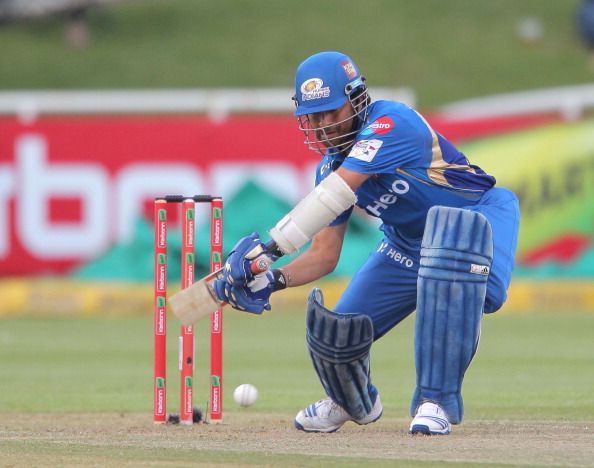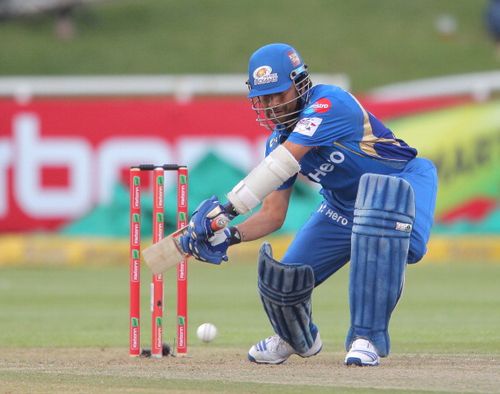
Sachin Tendulkar's jersey No.10 will be missed
I don’t hail from Mumbai nor do I make my living there. I don’t speak Marathi and my Hindi is limited to ‘Mujhe hindi malum nahi’. Yet, I’m a true Mumbai Indian. When Harbhajan slapped Sreeesanth, I cursed him. When they lost their way at the end of season one – losing matches they ought to have won – I cried. Like Ambani, I had worn same shirts on match days hoping it would bring good luck. I feared myself breaking something when they lost in the semis and finals consistently. They were a bunch of under-performing overachievers.

Sachin Tendulkar in action for the Mumbai Indians
Still it was my team. It always felt so. Like a magnet attracting iron filings towards it, Sachin attracted me. There is more to him than just numbers and records. Sachin has a different meaning to many. He makes people like me cross borders, forget a team from their city to support his. He transformed how One Day cricket was played. Many greats could stake a claim to be better than him or equal to him in Tests. But in coloured clothes, he is unparalleled. The game evolved with him. It’s sad that we will not see him wearing his No.10 jersey after this tournament.
In many ways, he symbolizes Mumbai Indians. The team has grown with him. At times, they had relied too heavily on him. For those who followed Mumbai closely know the Tendulkar effect. Much of the first season was lost due to a groin injury. In a close match against Punjab, he got out at the wrong time. Yet, he went to Robin asking him to stay calm and steer his team home. They lost by a run as Yuvi tried a Jonty. In a must-win against Rajasthan, Sachin took a magnificent catch to dismiss Watson. The subsequent reaction demonstrated the commitment he has to the team.
The second season was a disaster. They never got the team right, struggled to win consistently. Sachin’s captaincy was below par too. Yet, he tried to inspire constantly. He saved himself and Sanath for the latter half against Rajasthan. The move backfired as they lost too many wickets for too few runs. He stood there absorbing pressure, delaying the charge. When he got out, Nayar briefly threatened to pull off a heist before the left-hander did a Tendulkar. He left the crease without realizing where the ball was.
Third season was the best he played as a player and captain. He came on top of the leading run scorers list. The way he handled Rayudu and Tiwary was highly laudable. By promoting them, giving them responsibilities, he constantly surprised the opposition. They would have won the title, except for the brain fade at the end. Enough has been debated about the decision to delay Pollard. The innings against KKR, where he took apart Ishant Sharma, was a true master-class.
Fourth season saw him giving up captaincy to Harbhajan. The image of that season was the hundred he made against Kochi. For a man known to make centuries, this was the icing on the cake. 100 in a T20 is not that easy especially for a non-power hitter. The innings wasn’t a masterpiece. Still, it had Tendulkar’s authority all over it.
In the eliminator against Chennai, Mumbai were chasing a big target. The openers started to find some rhythm when a mix-up occurred. Sachin, fully aware of who the better batsman was at that moment, decided to sacrifice his wicket. He went to Dwayne Smith to remind him of a bigger cause before walking back to the pavilion. In another match against the same opposition in Mumbai, they faced another stiff task. Rohit and Sachin made batting look easy that day. A master and disciple were on display.
The sixth season finally broke the hoodoo. The opening combination of ageing superstars enticed many to turn up before their TV sets. Even though they failed, it was a treat to see them walk together. An injury prevented him from playing the last few games including the finals. The season also saw him dropping the bombshell – his retirement from the shortest format. The smiles of winning the cup were coupled with the sadness of his subtle announcement.
The stint with Mumbai Indians provided an opportunity for him to share his ideas with youngsters who, otherwise, would never have a chance to bat with him. His glaring captaincy errors overshadowed some of his brilliance. As a batsman, he improvised, innovated and evolved as a T20 pro. And we got to see an emotional Tendulkar at times. CLT20 provides him with one last chance to do all these.
I wouldn’t be surprised if the support for Mumbai Indians dwindles in the forthcoming seasons. Number 10 for one last time!